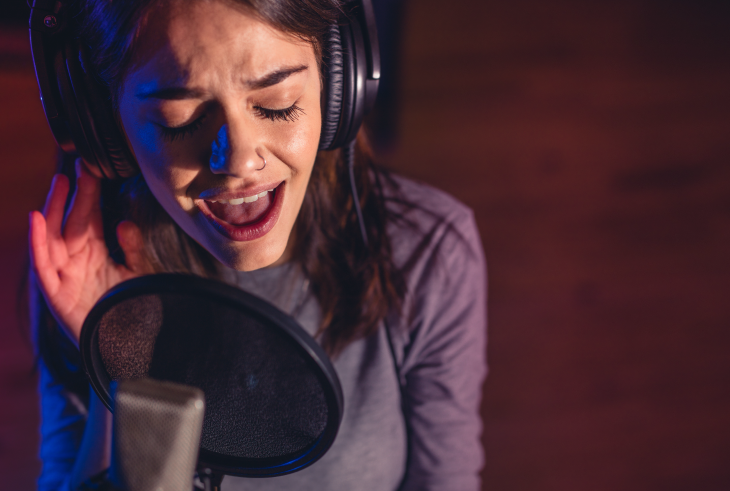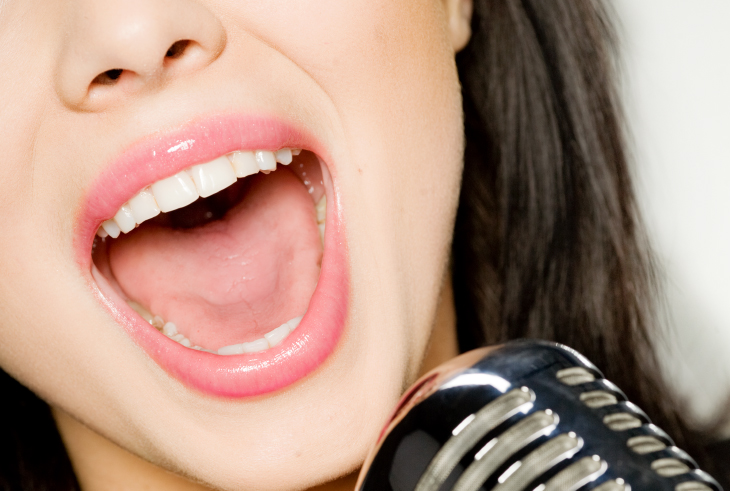Ep 3 Live Q&A – March 6 2019 – How does posture affect your voice?
Mike Elson: Yeah. So, the question number three … no, this is the posture one that I have, okay?
Matthew Edwards: Posture point. Yeah.
Mike Elson: So, this one is, how does posture affect your voice? This one comes in from [Kayleigh 0:00:00:21:46]. Thank you for writing in this question. So, how does posture affect your voice?
Matthew Edwards: Yeah. So, it’s hard to show you in a 2D webcam broadcast, because this is one of those things that’s really helpful to do in a room where you can walk around each other or if we had a camera set up where we could really stand up and show you more of the full-body, head to toe, right? I’ve been in workshops with a physical therapist where she literally went around to every singer and looked at their ankles and then she would look at how their feet were rolled in or rolled out. She would tape their ankles and she would first put marking so we could see their posture and maybe take a photo of it and then go down and tape their ankles so that their ankles were better aligned and then go back and you would watch the shoulders level out.
Mike Elson: What?
Matthew Edwards: Yeah. It was the most fascinating thing. One of the most fascinating workshops I’ve ever sat through. What she was saying is a lot of us end up with something where we compensate our foot rolls in and then because as soon as your foot rolls in, that’s the base of your entire structure. So, then your leg, your knee rolls in, then that pulls on your hip and then [crosstalk 00:22:53]
Mike Elson: Oh man, that’s just like with running, right? You go get the shoe. They’re like, “Do you pronate or supinate?” It’s like, “Which way does your leg go when you strike the ground?” So, the same concept with the whole thing sets up how you carry yourself.
Matthew Edwards: It really does. So, that becomes … footwear becomes an issue, right? So, when you’re learning to practice doing it in bare feet or doing it in flats or athletic shoes is fine. If you start trying to pop on heels though, as soon as you put on heels, it starts to change your posture and you’re going to feel a difference, right? There’s actually some research that’s been done where they’ve looked at how high heels affect posture and there is a significant change in the way you align your neck and then the acoustic output from your voice. So, if you’re going to perform a lot in heels, you want to practice in them. Excuse me, you want to make sure that you’re practicing in them and not just jumping into them as soon as you walk into that performance, right?
Mike Elson: It’s a weird day when I’m practicing in my high heels. I left it for Kinky Boots which is a great show by the way if you haven’t seen it on Broadway.
Matthew Edwards: It’s an awesome show. I actually have a student in the national tour of it right now. Yeah, those are some crazy boots. I did a production of Carmen one time where they ordered for me the Spanish heels to wear. The first time I walked on there, I had a new appreciation for singers who wear them when they perform because it throws your body off. It’s different.
Mike Elson: I bet. For sure.
Matthew Edwards: So, you want to look at how your legs are lining up. You don’t want to be locked knee. If you’re locking your knees, it throws your hip out. So, you want your knees to be loose. Feet about shoulders width apart and then you want to feel like your pelvis just rests on your thigh bone so that it’s there. So, you can find that by just moving your hips around, rocking them back and forth left to right, shift around. One of the things you can always do if you’re not sure then lay down on the ground. When you’re on the ground, lay down.
Matthew Edwards: Sometimes you’re going to have to put a book behind your head. If you find that your neck when it’s laying against the ground and your back is as well, if everything feels out of whack right here, start putting up some small thin books and so it feels you’re in better alignment. Then you can put your toes up and then rock on your heels back and forth and left to right to start to try to get your body to rock into the ground to find a cleaner alignment, right?
Matthew Edwards: Then after you start to feel what that feels like, you can stand up and see if you can replicate that in the standing position. So, that’s the bottom half of your bottom. That’s important because that’s what everything on the upper half rests on is on the pelvis. So, what happens is that if your pelvis is let’s say if you’re tilting forward like this, all of a sudden, your ribcage is all out of whack. When you go to breathe, your diaphragm is trying to go down at an angle. We need to make sure that your spine is in more of its natural curvature so that when you breathe, your diaphragm can descend up and down the way that it was built to move, right?
Matthew Edwards: Also, if you get out of whack in your spine, then it’s going to force some of those abdominal muscles to compensate in weird ways. It’s going to end up causing some of your back muscles that grab onto the ribs to compensate and you can end up getting into an awkward position as well.
Matthew Edwards: Then as we work our way up, we get to the neck. This is where people end up in a lot of trouble. If the posture is messed up along the way and they end up with a neck that’s like this-
Mike Elson: Like a turtle?
Matthew Edwards: Yeah like turtle neck where you’re all the way tucked in like this. So, what I’m going to do is just sing a pure ah vowel and I’m going to start in a neutral place then go forward then come back to neutral and then tuck my chin and come back to neutral. I’m going to only try to change my neck position. Pay attention to how the sound changes, okay?
Matthew Edwards: So, if I go (singing) right?
Mike Elson: Right. Yeah, big changes.
Matthew Edwards: Yeah. When I lean forward, it gets a really bright kind of strain sounding. When I tuck my chin, it got this weird like … sound within it as well, right? So, either tucking your chin too much can throw you off, lifting your chin up too much like this can mess things up as well. The way that I always like to explain this to my students is to think about a flute, right? If you have a flute player playing, that flute is designed with its tube to be in a straight line and that’s how it plays really well. The air travels through that. That’s how we get all of those notes to be sounded. The second that I take that flute and I bend it over my knee and hand it back to the flute player, it’s not going to play the same, right?
Mike Elson: Right.
Matthew Edwards: As singers though, a lot of times we end up bending our flute, right? So, for commercial singers, they have an easy reminder which is that microphone. That’s where a boom stand comes in. So, if you’re trying to play piano or play a guitar and you’re leaning over, you need to get a boom stand for your microphone that you can push that microphone back up at you, so you’re guitar can still rest in front of your keys can rest in front of you and the microphone rests right there in front of you.
Mike Elson: Right. So, literally, you can’t go forward without hitting the microphone.
Matthew Edwards: You don’t feel too good when you hit that grill up to you. So, that can be a really good help for people. Laying back down on the ground and singing in that supine position can also be a way for students to train their neck to stay out of the process and learn what it feels like to sing with a straight, stable, relaxed neck, right? When you’re on the ground, the postural muscles in the back of your neck let go because they serve no purpose when the ground is holding the weight of your head.
Mike Elson: Right.
Matthew Edwards: So, then the idea is as you start to program your body in that position that hey these muscles back here should not be involved, muscles in here should not be involved. You’ll feel it when you’re laying down there that your head will try to kick up and you have the floor behind you to help you notice when you start to jerk your head up and down, left, right. Then the goal is that you can eventually sit up and then can keep those muscles out of the way when you go to sing.
Matthew Edwards: Now with every vocal exercise we do, there can always be a potential negative. When you’re laying on the ground, it’s likely that you’re going to feel your tongue trying to really pull back. You might feel like your soft palate doesn’t want to lift and your voice gets really nasally. You may feel some extra jaw tension that’s not usually there, okay? So, sometimes this exercise causes more negative side effects than its worth. Then other times, it works perfectly fine. So, you have to take every exercise and figure out if it’s giving you the results that you’re looking for or if its something that may not be for you or if you may need an instructor there with you to help guide you through the exercise and make sure you’re doing it in the best way for your body and your voice.
Mike Elson: Make sense. Absolutely. Moving on.
about the author
Mike ElsonMike loves to sing and make magic happen with computers and music. After trying lots of ways that didn't work to find his head voice, his voice ended up broken and his concepts mixed up. Before there was Google, he rebuilt his technique from square one with Dr. Joel Ewing, providing him plenty of humility and loads of first-hand empirical knowledge about the inner workings of the voice. Mike strongly believes that "everyone should be trained as a tenor," because of the additional skills required in balancing registration for this specific voice type. He has enjoyed singing in Mrs. Kim Barclay Ritzer's award-winning GVHS choir in Las Vegas, Nevada and with Dr. Dhening's internationally acclaimed USC Chamber Choir in Los Angeles, CA. Mike brings his passion for singing along with his pedigree to bring the voice training industry a new platform to make online voice lessons more successful, help choirs raise funds, and grow better singers. VoiceLessons.com is a way to pay it forward to a new generation of singers who are looking to start their training or take their voices to the next level by searching for options online. Welcome, and enjoy!
RECENT ARTICLES
RECENT IN KNOWLEDGE
Recent Topics
- Beginning Voice Lessons (1)
- Breathing Techniques (1)
- Confidence (1)
- Experienced Teacher (1)
- Kids Singing Lessons (1)
- Musical Career (1)
- Practice (1)
- Private Lessons (1)
- Professional Singer (2)
- Sing (1)
- Singing Teachers (2)
- Style (1)
- Teach Online (1)
- Vocal Exercises (1)
- Vocal Health (1)
- Vocal Music (1)
- Vocal Pitch (3)
- Vocal Range (4)
- Voice Coach (1)
- Voice Exercises (2)
- Voice Training (4)
- Young Vocalist (1)
Categories
- Basic Skills (7)
- Beginners (8)
- Career (2)
- CCM (1)
- Contemporary Commercial Music (1)
- Crossing Over (1)
- Exercises (2)
- Online Lessons (3)
- Online Voice Lessons (1)
- Songs (2)
- Students (6)
- Tips (4)
- Vocal Coaches (1)
- Voice Teachers (2)
- Warmups (2)
Testimonials




-
Ep 10 Live Q&A - April 24, 2019 Question 7 - How do I shape my mouth when I sing vowels?
-
Ep 10 Live Q&A - April 24, 2019 Question 1 - How do you control a vibrato that is too fast?
-
Ep 4 Live Q&A - March 13, 2019 - How do you know your voice is damaged?
-
Ep 3 Live Q&A - March 6 2019 - How much breath do you need to support a good belt?
-
No Post Found!!







